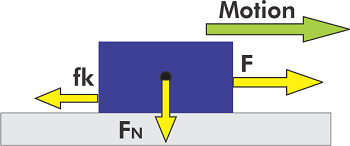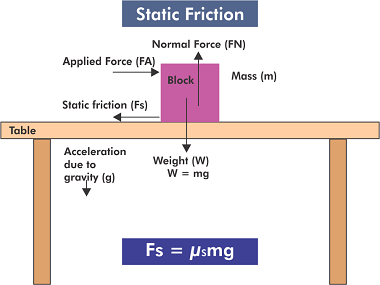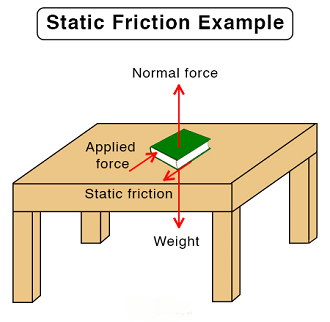Static Friction DefinitionWhat is Friction. Give Suitable ExampleFriction is defined as whenever an object travel or tends to travel over the surface of another object, a force acts that resists the relative motion. The resistive Force is termed Friction. 
Example Assume a square wooden block is lying on a horizontal surface. Give a normal push. The block will travel a smaller distance and come to a halt position. As per Newton's second law of motion, the wooden block's motion will be impeded by Force known as Friction. The Force acting in opposition will be applied tangentially to the surface of contact and opposite to the direction in which the object moves. Friction: A Component of Contact Force Friction as a component of Force: When two bodies come into contact, an attractive force exists between the particles at the surface of contact, which includes Friction as one of its components. As a result, both objects apply a contact force on each other. These joint contact forces are opposite and equal. Newton's third law of motion has stated this. Normal Force, also known as Normal Reaction, is the portion of the contact force "F" perpendicular to the contact surface. The component that is parallel to the contact force is termed Friction. Friction: Explain its OriginOrigin Friction occurs due to atomic or molecular forces of attraction between two surfaces at their points of real contact. However, due to surface irregularities, the actual contact area is much smaller than the apparent contact area, resulting in very low pressure at the surface contact points. Molecular bonding occurs at these surface points, but when one object is moved over the other, the bonds break, causing deformation in the objects and developing new bonds. This deformation generates local vibrations that propagate into the objects, and the resulting vibrations dissipate energy, which is converted into heat. Consequently, an external force is required to initiate or maintain the body's motion. Different Types of FrictionNamely, there are three types of Friction: Kinetic, Static, and Limiting Friction. But will limit it to static Friction. 
Static FrictionIt is an adjusting force. Consider a metal block kept over a square table. Offer a gentle force F to it. The block won't slide or move. The Force of Friction, which comes into action between the two objects before one object begins to slide over the other, is termed Static Friction, and it is denoted by fs. Static Friction resists the impending motion. As the applied Force on the block is escalated, the static Friction fs Also escalates to stabilize the applied Force is escalated beyond the limit, and the block starts to move. At this point, static Friction is maximum. fsmax denotes the maximum Force of static Friction that comes into action when an object starts to move over the surface of another object, and it is termed limiting Friction. It is very clear fs≤ fsmax Once the motion starts, the Force of Friction reduces. A little force is needed to maintain a uniform motion. 
The Frictional Force, which comes into action when an object is in a condition of steady motion over the surface of another object, is termed dynamic or kinetic, and it is denoted by fk Friction. The object travels with uniform velocity v when F = fk. The kinetic Friction resists the actual relative motion. When the applied Force becomes greater than the kinetic Friction, the block accelerates with acceleration, and it is equal to ( F- fk)/m. The Coefficient of Static Friction, represented by the proportionality constant , denotes the ratio of limiting Friction to the normal reaction. The Laws of Limiting Friction dictate that the maximum Force of static Friction is not related to the area of contact but is proportional to the normal Force. The direction of the limiting Force of Friction is always opposite to the direction of movement, and it exerts tangentially on the two surfaces' interaction. The limiting Friction's magnitude depends on the surface interaction's evenness and nature, and it is proportional to the normal reaction between the two surfaces. For a given pair of surfaces, as long as the Normal reaction is constant, the magnitude of the limiting Friction remains independent of the area or the shape of the surfaces in contact. Frequently Asked QuestionsQuestion: What is sliding Friction? Answer: It is defined as the opposition that is formed between two bodies when they are sliding against each other. Question: Give a formula for the measurement of the frictional Force. Answer: The Force of Friction is provided by the formula: F= usN us = It denotes the coefficient of static Friction N = Normal reaction between the two touched surfaces. Question: How does the Force of Friction generate heat? Answer: When the bodies move against each other, the Force of Friction between the surfaces of the two bodies turns kinetic energy into heat. Question: Determine the Force of Friction is a vector or scalar quantity. Answer: The Force of Friction is a vector quantity since it contains both directions and magnitude. Numerical ProblemsQuestion: A body weighting 20 N is placed on the horizontal table, and T is the tension that can be enlarged to 8N before the block begins to move. A force of 4N made the block move at uniform speed once it came into motion. Determines the coefficient of static Friction. Solution: For static Friction The given relation for the vertical and horizontal components of forces R - mg = 0 R = mg = 20 N T - fsmax = 0 fsmax= T = 8N Therefore, the coefficient of Friction is given by: 
Question: A mass of 4kg is kept on a horizontal plane. The plane is slowly inclined until at an angle of θ = 15° with the horizontal, and the mass begins to slide. Determine the coefficient of Static between the surface and the block. Solution: The quantities given are: θ= 15° This is called an angle of repose. There, the coefficient of Frictsion μ = tanθ 0.27 = tan 15° Question: What is the maximum acceleration of a train at which an object placed on the floor of the train will remain stationary, given that the coefficient of static Friction between the floor and the object is 0.15 and Use g = 10ms-2. Solution: To solve this problem, we can use the following formula: Maximum Acceleration = Coefficient of static Friction x acceleration due to gravity Given that the coefficient of static Friction between the train's floor and the box is 0.15 and g = 10ms-2, we can substitute the values in the above formula as follows: Maximum Acceleration = 0.15 x 10 = 1.5 m Therefore, the maximum acceleration of the train at which an object placed on the floor of the train will remain stationary is 1.5 m .
Next TopicBookkeeping-Definition
|
 For Videos Join Our Youtube Channel: Join Now
For Videos Join Our Youtube Channel: Join Now
Feedback
- Send your Feedback to [email protected]
Help Others, Please Share










